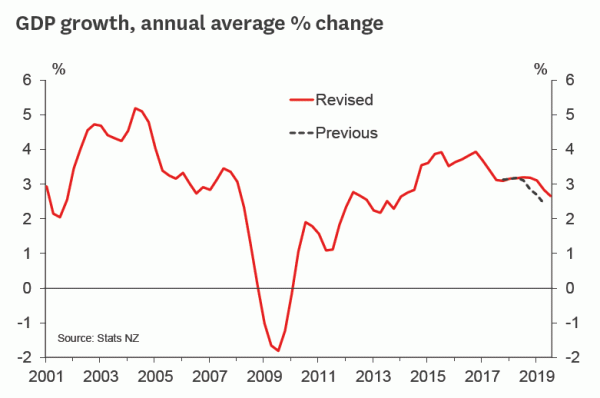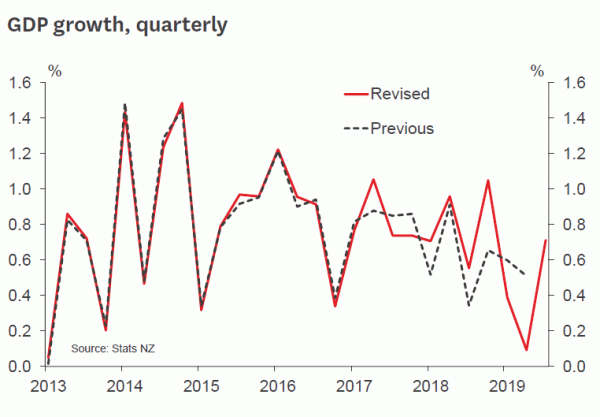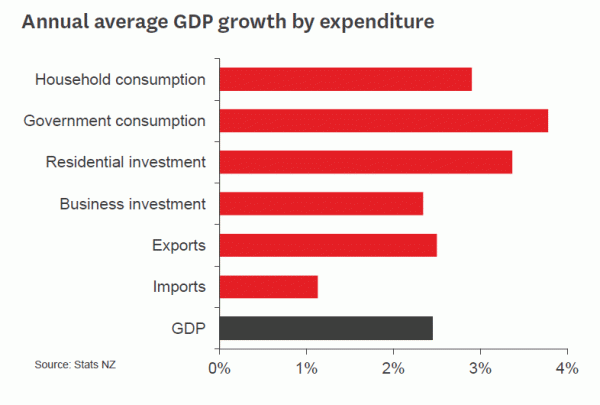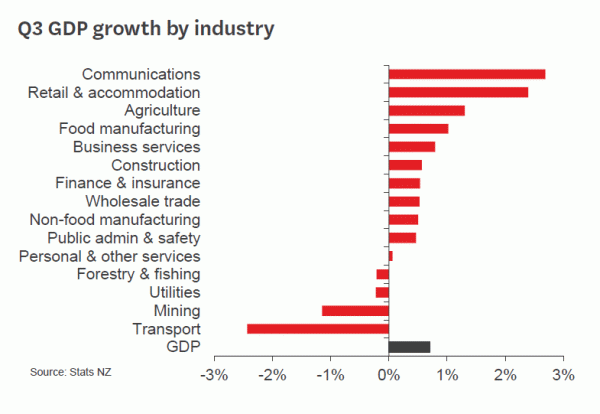- GDP rose by 0.7% in the September quarter, a stronger than expected rebound after a sharp slowdown in the first half of the year.
- The annual revisions to the national accounts have revealed a substantially different picture of the economy’s recent performance.
- Rather than a gradual slowdown in growth over the course of the last two years, the economy appears to have continued to grow at a solid pace in 2018 before hitting a two-quarter pothole in 2019.
- A range of indicators suggesting that momentum has picked up again in the last few months.
- We expect growth to return to around a 3% annualised pace next year.
- On balance, the revised GDP figures suggest that the economy has been running a little hotter than the Reserve Bank thought, making further OCR cuts less likely
At a first glance today’s GDP release was a mixed bag, with a stronger than expected pickup in the September quarter, but a sharp downward revision to growth over the first half of the year. However, it was Stats NZ’s annual round of revisions to the national accounts that proved to be the most revealing. Economic growth appears to have been more persistent in recent years, with a shorter-lived slowdown this year, than previously thought.
The GDP revisions, which incorporate more detailed industry information that is often only available on an annual basis, have had two effects. The first is that the pace of growth over 2018 has been revised up substantially, with growth for the calendar year now estimated at 3.2%. This implies that, rather than gradually slowing over the year as previously reported, growth in 2018 was on a par with the previous year – an even more impressive result when you consider that population growth was slowing down in that time.
The second effect is that what was previously reported as a further gradual slowdown in the first half of 2019 now looks more severe – quarterly growth slowed to 0.4% in March and just 0.1% in June. These revisions came as a surprise to us, but the new figures probably fit better with what we heard from businesses at the time. Surveys of business confidence have been down in the dumps for a while, but it wasn’t really until this year that we heard firms talking about a softening in demand.
The 0.7% rise in September quarter GDP was higher than we or the market expected, but it helps to underscore our view that the economy is now past its low point. In recent months there has been a growing range of evidence that points to a lift in momentum. We expect GDP growth to improve to around a 3% annualised pace in 2020, supported by low interest rates, rising government spending and a more buoyant housing market.
While the 0.7% rise for the September quarter was substantially higher than the Reserve Bank’s forecast of 0.3%, what will matter more is how the revisions to history affect its assessment. On balance, the revisions suggest that the economy is running a little hotter than the RBNZ had expected, making today’s result a modest upside surprise in terms of its outlook for the OCR.
Today’s figures illustrate why we were circumspect about the chorus of calls for fiscal stimulus earlier this year. Not only is government spending already outgrowing the wider the economy by a sizeable margin, but the revised GDP figures point to a much shorter and more recent slowdown in growth than previously thought. Fiscal policy is desperately ill-suited to dealing with short-term swings in growth – it takes a long time to get it going, and by the time it arrives it can end up exacerbating an upturn rather than countering a downturn. Leaning against the cycle should be left to monetary policy, which is nimbler – and indeed has already proven its worth this year.
Details of the GDP data.
The 0.7% rise in the production measure of GDP exceeded our 0.5% forecast, although the details were largely similar to what we expected. Retailing made the strongest positive contribution, growing by 2.4% – even more than what the earlier retail trade survey had indicated. Telecommunications recorded a 2.7% gain, picking up the pace after some soft outturns in previous quarters. There were also moderate gains in agriculture, manufacturing, construction and business services.
The surprise relative to our forecast – and indeed the changes to previous quarters – was largely a product of the annual revisions, which have altered the mix of growth by sector. Construction’s share of GDP was revised up, due to better information on infrastructure spending, and owner-occupied property services were revised up to reflect the growth in the housing stock in recent years. These were partly offset by downward revisions to transport and healthcare, reflecting the fact that recent growth has been driven more by prices and less by real activity than previously thought.
The expenditure measure of GDP rose by 0.6% for the September quarter. While this measure is considered less reliable on a quarterly basis, looking at over-the-year measures provides a useful lens on the recent drivers of growth.
Growth has in fact been reasonably broad-based over the last year. There are some clear standouts, in the form of construction (both residential and non-residential) and government spending. But household spending, business investment and exports have seen solid gains over the last year as well.


















